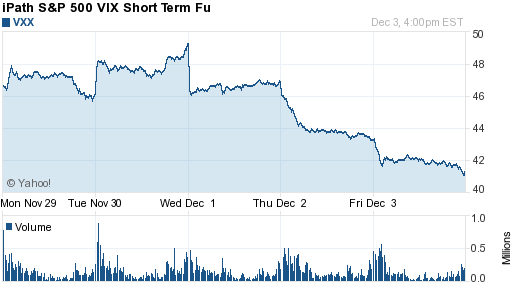I have discussed this before, but it bears watching. Volatility is at a relative low point in relation to the past thee years:

The events in late 2008 strictly related to the financial crisis (the downfall of Bear Stearns, Lehman), and volatility remained relatively high through the first half of 2009 before calming down.
The markets reached some sort of complacency in the first quarter of this year, before volatility rose again with the advent of the European (Greek) sovereign debt crisis. This resolved, and volatility is dipping again.
It may lower even further, but traditionally volatility is anti-correlated to index performance – the higher volatility goes, the lower the underlying index. Some people have the misconception that the VIX is predictive; it is not, but it can be used as a barometer of market’s future expectations of volatility.
One might be lead into believing that buying and selling volatility itself, compared to the underlying index, may be the financially wise way of playing this. Unfortunately, it is not so easy – the above chart is equivalent to a “spot rate” on volatility – mainly the volatility over the next 30-day period. There are products that are designed to trade volatility directly (VIX futures), but in order to sustain a position, you must take rollover risk.
For example, if you think volatility is going to rise in December, you can buy the December future. But if the volatility does nothing between now and the December expiry (third Friday in December), you must sell your December position (or settle it with cash) and then purchase the January future, which may have a significantly different price than December.
There is an exchange-traded fund, (NYSE: VXX) which performs the same function (for a 0.85% management expense ratio):

As you can compare with the first chart in this post, there is correlation, but during “dull” moments, the ETF is absolutely destroyed by the rollover process. This is similar to most natural resource ETFs (e.g. UNG) which are also destroyed by traders picking away at the automatic rollover.
Rollover risk is somewhat mitigated by the (NYSE: VXZ) ETF, which uses futures that are dated roughly 6 months in advance, but this has tracking error with existing volatility – current volatility may spike, but the future 6 months out might not track the current action.
There is clearly no free lunch in trading volatility – it is not as easy as looking at the VIX chart and thinking you can “buy” it, thinking you are buying low and preparing to sell high. Almost like options, not only must you get the direction correct, but you must get the timing correct, which is not easy.
Traders might be allured by past price action (e.g. this year, doubling your money buying in April, and selling in May), but your timing must be absolutely sharp. There is no way to determine that buying at 75 and selling at 150 was the proper decision except purely in hindsight.
You can even buy options on VXX, but note that the traditional implied volatility calculation (based on the Black-Scholes model) has little to do with properly valuing options on volatility futures – more so with this option than traditional equity options!





